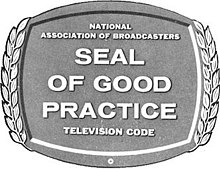Code of Practices for Television Broadcasters: Difference between revisions
No edit summary |
|||
| Line 11: | Line 11: | ||
==See also== |
==See also== |
||
*[[National Association of Broadcasters]] |
*[[National Association of Broadcasters]] |
||
*[[Hays Code]] |
|||
==References== |
==References== |
||
Revision as of 00:18, 16 December 2011
The Code of Practices for Television Broadcasters was a set of ethical standards adopted by the National Association of Broadcasters (NAB) for television. The code was established on December 6, 1951. Compliance with the code was indicated by the "Seal of Good Practice", displayed during closing credits on most United States television programs from 1952 through the early 1980s.

The code prohibited the use of profanity, the negative portrayal of family life, irreverence for God and religion, illicit sex, drunkenness and addiction, presentation of cruelty, detailed techniques of crime, the use of horror for its own sake, and the negative portrayal of law enforcement officials, among others. The code regulated how performers should dress and move to be within the "bounds of decency". Further, news reporting was to be "factual, fair and without bias" and commentary and analysis should be "clearly defined as such". Broadcasters were to make time available for religious broadcasting and were discouraged from charging religious bodies for access. Most importantly, it limited the commercial minutes per hour.[1]
Under pressure from broadcasters, the code was suspended in 1983.[2] [failed verification]
See also
References
- ^ Code of Practices for Television Broadcasters Television History - The First 75 Years
- ^ "The Code" Jeff Jarvis
External links
- Text of the Code of Practices for Television Broadcasters
- The Television Code - Fifth Edition, March 1959 Complete with Interpretations and Amendments. Courtesy of J. Alan Wall's TV-signoffs.com
